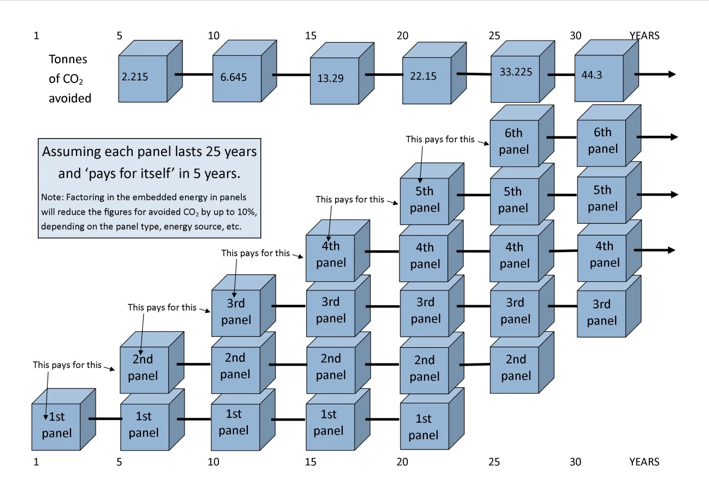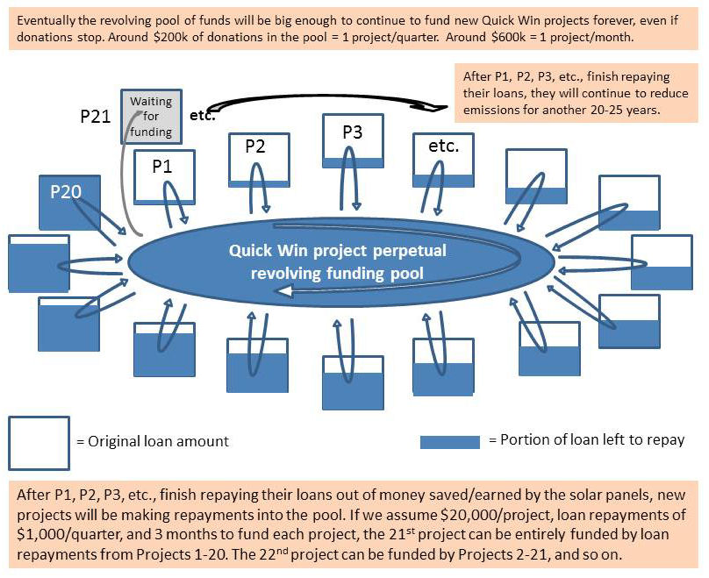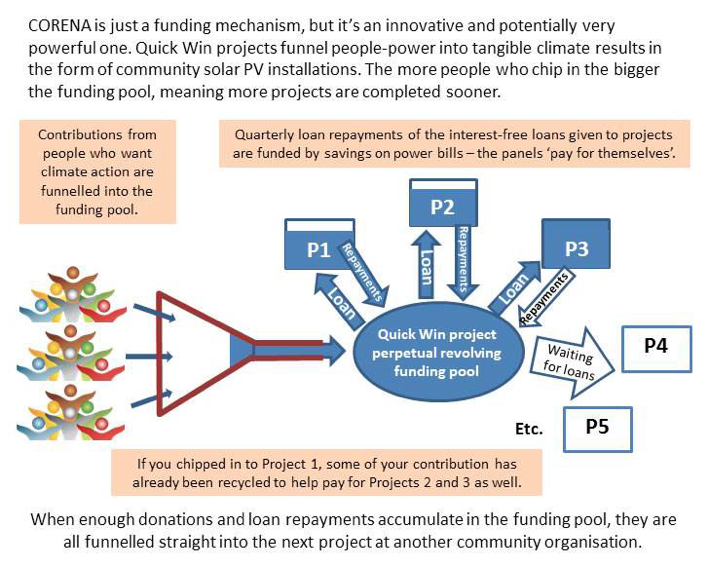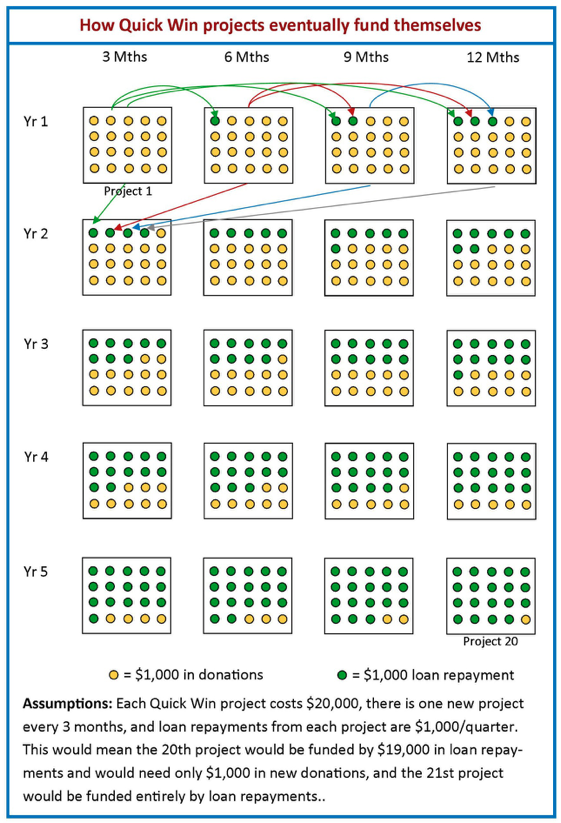Quick Win Project Model
The Quick Win project model is a donation-based model featuring a revolving funding pool.
What it is
The model relies on voluntary contributions of any amount from citizens who wish to take an active part in tangible climate action (reduction of carbon emissions) for the sake of the common good. The funds are used to provide interest-free loans to non-profit community organisations to pay for solar PV, solar H/W, and/or energy efficiency measures. The loans are repaid into the Quick Win revolving funding pool just out of savings on power bills, and are then used over and over again to help fund subsequent Quick Win projects.
The main strengths and benefits of this model are:
- Project hosts are relatively easy to find because particular tariff circumstances enabling specific levels of ROI are not required.
- Projects can be implemented by any incorporated association.
- Relatively little time, effort, or specialised skills are required to find suitable project hosts, raise funds, and implement the project.
- Anyone anywhere in Australia (or overseas) can be part of achieving the project outcome (and empowered by that).
- The only required legal instrument is a sound loan agreement template. (CORENA is happy to share the one we had drawn up for us.)
- Many community organisations cannot install solar because they simply do not have the capital. This model makes it easy for even the poorest organisation to do so.
- Since repaid funds revolve into subsequent projects, over time any particular donated amount achieves roughly 5 times as much as it achieves in its first project. For example, if someone donates the cost of one solar panel, that panel will 'pay for itself' in around 5 years and that money is then used for another panel, then another, and so on. By the time the first panel reaches the end of its lifespan, there'll be a 6th panel installed, so there will always be approximately 5 panels worth of benefit going forward in perpetuity (see Figure 1).
- Projects will eventually become financially self-replicating (see Figure 2).
Figure 1. How one panel grows into approximately 5 panels

Source: CORENA (http://corenafund.org.au/quick-win-projects/)
Figure 2. How the revolving pool keeps funding new projects

Source: CORENA (http://corenafund.org.au/quick-win-projects/)
The installation and any energy efficiency work is owned and maintained by the community organisation from the outset. After the loan is repaid (approx. 4-5 years), all subsequent savings on power bills for the remaining lifespan of the installation simply reduce the organisation's overheads so that they have more money available to fund the community services they provide. Thus, community organisations can install solar at no cost to themselves, and everyone receives the benefit of lower carbon emissions (see Figure 3).
Figure 3. Overview of CORENA Quick Win project model

Source: CORENA (http://corenafund.org.au/quick-win-projects/)
What it isn’t
It isn't an investment-based project model. This means funds can be used over and over again rather than being returned to individual investors, and specific ROI requirements need not be met for the model to be viable.
It's also not purely a gift model even though it doesn't cost the recipient organisation a cent. The solar installation or similar 'pays for itself', and the money earned/saved by the project is what pays back the interest-free loan into the revolving funding pool.
This model is not crowd-funding in the usual sense. Crowdfunding platforms have numerous disadvantages and no real advantages for a long-term revolving funding model that will potentially involve large sums of money.
What is this model most fit for purpose for?
This model is most fit for solar installations and energy efficiency measures for 'deserving causes' where a significant portion of their electricity use is during the day (at least 5 days/week). Solar PV installations of up to 10kW are ideal - less if on-site usage is low or donated funds are likely to be limited. Most of the generated solar power should be used on site rather than exported to the grid to minimise payback times and maximise the amount of money available in the revolving fund for subsequent projects.
The model will suit any incorporated group who want to implement a series of small Quick Win projects over a period of years. For example, if the group can attract enough donations to fund one project a year, after 5 years (assuming a payback period of 5 years) the loan repayments alone will continue to fund one new project every year, forever.
Theoretically this revolving fund model could also be used to fund projects for businesses or homeowners, but it is obviously easier to attract voluntary contributions if the project recipient is considered to be a deserving cause.
Essential requirements for viability
The essential requirements for this model to be viable are:
- A series of project hosts with suitable roof space and regular daytime electricity use
- A mechanism for soliciting and receiving donations, and an account for depositing donations, issuing loans, and receiving loan repayments
- Access to professional product and installation advice to ensure high project quality
- Admin people (preferably volunteer) to promote project fundraising, manage and report donations and loan repayments, and assess and liaise with prospective project hosts
- Transparent financial and project reporting so that the public can see how donated money is used, and preferably annual financial audits (essential if the group implementing the project has DGR status)
Constraints
This model is most suitable for projects for community organisations that own their own building, although ones with secure long-term leases are possible with permission of the owner (generally council- or state-owned premises).
The ability of the host to reliably repay the loan should be considered, with contingency clauses included in the loan agreement, since there is a responsibility to donors to maximise the benefit of their contributions by having funds revolve through to future projects.
This model is theoretically suitable for projects of any size, but the size/cost of projects should be in balance with the amount of money that can be raised quickly enough to be a 'quick win'. Donors want their money to be used in a project and start reducing emissions reasonably soon after they donate it.
A first project is the hardest to fund because all funds must be donated. Subsequent projects get progressively easier to fund as more and more projects start making quarterly loan repayments back into the funding pool (see Figure 4).
Figure 4. How the project proportion funded by loan repayments grows

Source: CORENA (http://corenafund.org.au/quick-win-projects/)
How to utilise this model
Regional renewable energy groups or climate action groups typically have members who are impatient for tangible outcomes. Such a group can apply this model at whatever scale suits them in order to achieve some quick outcomes, perhaps while they work through the process of setting up a larger more complex investment-based project.
The model could be tweaked to suit the aims of the group. For example, this model could be used until a larger investment-based project is ready to start seeking investors. At that point the plan (publicised in advance) could be to start directing all Quick Win loan repayments to the larger investment-based project. The initial Quick Win projects would provide a good opportunity for involvement by people who could donate a small amount but could not afford to invest directly in the larger project. It would give all supporters something they could help achieve, not just those with the specialist skills required for setting up a large investment project.
Alternatively, any renewable energy group is welcome to partner with CORENA to fund a Quick Win project in their local community. The local group would initiate the project and liaise with the host organisation, and help build local interest in and support for the project. CORENA would provide the admin role and promote the fundraising effort nationally. Since loan repayments and donations from other areas of Australia would help reach the funding target, this would be a relatively quick and simple way to achieve a one-off small local project.
Note: CORENA currently has a couple of projects in the funding queue, and we'll need to finish funding those before starting to fund a new project, but they are happy to add new projects to the queue. In fact, their preferred way of operating is to partner with a local group, particularly for projects in communities a long way from Adelaide.
What not to do
- Don't forget to check for possible energy efficiency measures at the host site. A combination of energy efficiency and a small solar PV installation can be more cost effective than spending all the project funds on solar.
- Don't risk damaging your group's public credibility by using cheap and possibly unreliable components.
- Don't try to fund more than one project at once. Finish one, then move onto the next so that donated funds are put to use as promptly as possible.
Key lessons from other groups using this model
There was no direct model for us to learn from for donation-based funding of renewable energy projects, but we did extrapolate from several key observations concerning the Hepburn Wind project.
-
We noted that some investors in that project were motivated primarily by the desire to see the tangible outcome rather than by a particular desire for a financial return on their investment, suggesting that a donation-based model could work.
- We noted that it was very involving and empowering for the local community but left people in other states and territories out in the cold, so we wanted to develop a model that could involve and empower everyone regardless of where they live.
- To us it seemed a pity that such a wonderful project, which took years of dedicated effort to achieve, did not somehow automatically help fund subsequent projects.
Getting assistance and finding out more
CORENA is happy to answer any questions about how to implement the Quick Win model. A lot of detail can be gleaned simply from a thorough read of the website, but if anything is not clear feel free to ask them what we do, or why we do things the way they do.
Intellectual Property
A copy of their loan agreement template is available on request. There are no restrictions over copying the Quick Win project model or methods.
